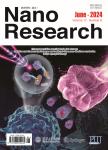Structural, optical, and electrical properties of phase- controlled cesium lead iodide nanowires
Structural, optical, and electrical properties of phase- controlled cesium lead iodide nanowires作者机构:Department of Chemistry University of California Berkeley California 94720 USA Materials Sciences Division Lawrence Berkeley National Laboratory Berkeley California 94720 USA Kavli Energy Nanosciences Institute Berkeley California 94720 USA Molecular Biophysics and Integrative Bioimaging Division Lawrence Berkeley National Laboratory Berkeley California 94720 USA Department of Physics University of California Berkeley California 94720 USA Department of Materials Science and Engineering University of California Berkeley California 94720 USA
出 版 物:《Nano Research》 (纳米研究(英文版))
年 卷 期:2017年第10卷第4期
页 面:1107-1114页
核心收录:
学科分类:0808[工学-电气工程] 0809[工学-电子科学与技术(可授工学、理学学位)] 07[理学] 0805[工学-材料科学与工程(可授工学、理学学位)] 0702[理学-物理学]
基 金:supported by the U.S. Department of Energy, Office of Science, Office of Basic Energy Sciences, Materials Sciences and Engineering Division the Physical Chemistry of Inorganic Nanostructures Program supported by the Office of Science, Office of Basic Energy Science, of the U.S. Department of Energy NSF Graduate Research Fellowship
主 题:inorganic halide perovskite CsPbI3 phase transition stability
摘 要:Cesium lead iodide (CsPbIa), in its black perovskite phase, has a suitable bandgap and high quantum efficiency for photovoltaic applications. However, CsPbI3 tends to crystalize into a yellow non-perovskite phase, which has poor optoelectronic properties, at room temperature. Therefore, controlling the phase transition in CsPbI3 is critical for practical application of this material. Here we report a systematic study of the phase transition of one-dimensional CsPbI3 nanowires and their corresponding structural, optical, and electrical properties. We show the formation of perovskite black phase CsPbIa nanowires from the non-perovskite yellow phase through rapid thermal quenching. Post-transformed black phase CsPbI3 nanowires exhibit increased photoluminescence emission intensity with a shrinking of the bandgap from 2.78 to 1.76 eV. The perovskite nanowires were photoconductive and showed a fast photoresponse and excellent stability at room temperature. These promising optical and electrical properties make the perovskite CsPbI3 nanowires attractive for a variety of nanoscale optoelectronic devices.



